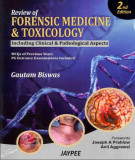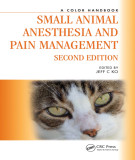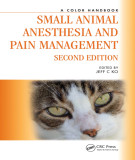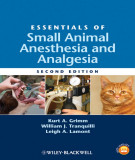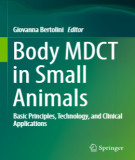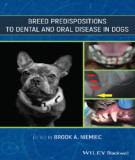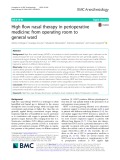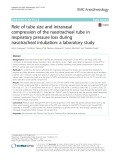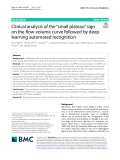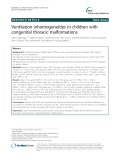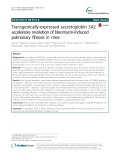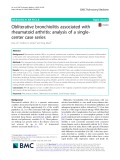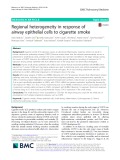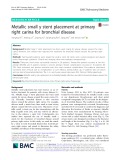
Small airway
-
Part 2 book "Small animal surgical emergencies" includes content: Stabilization techniques for patients with an upper respiratory obstruction, tracheostomy, brachycephalic airway syndrome, laryngeal paralysis, laryngeal trauma, tracheal collapse, stabilization techniques for patients with pleural space disease, diaphragmatic hernia, pyothorax, hemothorax, pneumothorax, lung lobe torsion, surgical approach to the thoracic cavity,... and other contents.
 407p
407p  muasambanhan10
muasambanhan10
 06-04-2024
06-04-2024
 3
3
 1
1
 Download
Download
-
Part 2 book "Small animal soft tissue surgery" includes content: Pectus excavatum; surgery of the thoracic wall; tumors of the thoracic wall; flail chest; pyothorax in dogs and cats oronasal and oroantral fistula; cleft lip and palate; brachycephalic airway syndrome; laryngeal paralysis; laryngeal neoplasia; tracheal surgery; surgical diseases of the lungs,... and other contents.
 695p
695p  muasambanhan07
muasambanhan07
 20-02-2024
20-02-2024
 9
9
 0
0
 Download
Download
-
Part 1 book "A color handbook - Small animal anesthesia and pain management" includes content: Equipment for inhalant anesthesia; perioperative blood work and urine analysis; preanesthetic medication - drugs and dosages; intravenous injection techniques and intravenous anesthetic agents; inhalant anesthetic agents; anesthesia monitoring and management; fluid therapy; blood components and transfusion therapy; injectable sedative and anesthesia–analgesia combinations in dogs and cats; anesthetic considerations for specific diseases; airway management and ventilation.
 243p
243p  muasambanhan05
muasambanhan05
 22-01-2024
22-01-2024
 4
4
 2
2
 Download
Download
-
Part 2 book "A color handbook - Small animal anesthesia and pain management" includes content: Anesthetic considerations for patients requiring upper airway surgery and patients requiring thoracic surgery; anesthetic considerations for upper and lower gastrointestinal endoscopic procedures; anesthetic considerations for minimally invasive surgical procedures; anesthetic considerations for neurologic patients; anesthetic considerations for ophthalmic surgeries,... and other contents.
 230p
230p  muasambanhan05
muasambanhan05
 22-01-2024
22-01-2024
 7
7
 2
2
 Download
Download
-
Part 2 book "Atlas of small animal CT and MRI" includes content: Thoracic wall and diaphragm; pleural space; mediastinum and esophagus; heart, pulmonary vasculature, and great vessels; airways; small airways and parenchyma; body wall, retroperitoneum, and peritoneal cavity; hepatovascular disorders; hepatobiliary disorders; gastrointestinal tract,... and other contents.
 308p
308p  muasambanhan01
muasambanhan01
 11-12-2023
11-12-2023
 7
7
 4
4
 Download
Download
-
Part 2 book "Essentials of small animal anesthesia and analgesia" includes content: Local anesthetics and regional analgesic techniques; anesthesia for patients with cardiovascular disease; anesthesia for patients with respiratory disease and/or airway compromise; anesthesia for patients with neurological disease; anesthesia for small animal patients with renal disease; anesthesia for patients with liver disease; anesthesia for patients with gastrointestinal disease,... and other contents.
 308p
308p  oursky10
oursky10
 04-12-2023
04-12-2023
 10
10
 3
3
 Download
Download
-
Part 2 book "Body MDCT in small animals" includes content: The systemic thoracic vasculature, the pulmonary vasculature, the lung and airways, the mediastinum and neck, the pleurae, thoracic wall, and diaphragm, cardiac CT angiography, cardiac DSCT,.... and other contents.
 194p
194p  oursky09
oursky09
 12-11-2023
12-11-2023
 5
5
 4
4
 Download
Download
-
Part 1 book "Breed predispositions to dental and oral disease in dogs" includes content: Conditions common in small and toy breed dogs, conditions seen in both small and brachycephalic breeds therefore small brachycephalic breeds (pug, lhasa apso, shih tzu, etc.) are even more significantly affected, the welfare concerns of heritable dental diseases, conditions commonly seen in brachycephalic breeds, brachycephalic airway disease, the unique welfare challenges of brachycephalism.
 114p
114p  oursky09
oursky09
 12-11-2023
12-11-2023
 3
3
 2
2
 Download
Download
-
High flow nasal therapy (HFNT) is a technique in which humidified and heated gas is delivered to the airways through the nose via small nasal prongs at flows that are higher than the rates generally applied during conventional oxygen therapy. The delivered high flow rates combine mixtures of air and oxygen and enable different inspired oxygen fractions ranging from 0.21 to 1. HFNT is increasingly used in critically ill adult patients, especially hypoxemic patients in different clinical settings.
 8p
8p  vampires36
vampires36
 30-12-2021
30-12-2021
 9
9
 0
0
 Download
Download
-
Small nasotracheal tubes (NTTs) and intranasal compression of the NTT in the nasal cavity may contribute to increasing airway resistance. Since the effects of size, shape, and partial compression of the NTT on airway resistance have not been investigated, values of airway resistance with partial compression of preformed NTTs of various sizes were determined.
 10p
10p  vampires36
vampires36
 30-12-2021
30-12-2021
 12
12
 0
0
 Download
Download
-
Small plateau (SP) on the fow-volume curve was found in parts of patients with suspected asthma or upper airway abnormalities, but it lacks clear scientific proof. Therefore, we aimed to characterize its clinical features.
 16p
16p  vimackenziebezos
vimackenziebezos
 29-11-2021
29-11-2021
 5
5
 1
1
 Download
Download
-
Congenital thoracic malformations (CTM) are rare lung lesions that are managed with surgical resection or active surveillance. The objective of this study was to comprehensively assess large and small airway function in children with CTM who underwent lobectomy in early life.
 9p
9p  vimontana2711
vimontana2711
 05-04-2021
05-04-2021
 16
16
 2
2
 Download
Download
-
Secretoglobin (SCGB) 3A2, a cytokine-like secretory protein of small molecular weight, is predominantly expressed in airway epithelial cells. While SCGB3A2 is known to have anti-inflammatory, growth factor, and anti-fibrotic activities, whether SCGB3A2 has any other roles, particularly in lung homeostasis and disease has not been demonstrated in vivo. The aim of this study was to address these questions in mice.
 13p
13p  vimontana2711
vimontana2711
 05-04-2021
05-04-2021
 8
8
 2
2
 Download
Download
-
The maximal expiratory flow at 50 % of the forced vital capacity (MEF50) is the flow where half of forced vital capacity (FVC) remains to be exhaled. A reduced MEF50 has been suggested as a surrogate marker of small airways disease. The diagnostic and prognostic utility of this easy to assess spirometric variable in persons with respiratory symptoms, but without COPD is unclear.
 8p
8p  vimontana2711
vimontana2711
 05-04-2021
05-04-2021
 8
8
 1
1
 Download
Download
-
Rheumatoid arthritis (RA) is a systemic autoimmune condition characterized by erosive inflammation of the joints. One rare pulmonary manifestation is obliterative bronchiolitis (OB), a small airways disease characterized by the destruction of bronchiolar epithelium and airflow obstruction.
 7p
7p  vimontana2711
vimontana2711
 05-04-2021
05-04-2021
 10
10
 2
2
 Download
Download
-
Sputum induction is an important noninvasive method for analyzing bronchial inflammation in patients with asthma and other respiratory diseases. Most frequently, ultrasonic nebulizers are used for sputum induction, but breath-controlled nebulizers may target the small airways more efficiently.
 7p
7p  vimontana2711
vimontana2711
 05-04-2021
05-04-2021
 9
9
 2
2
 Download
Download
-
Cigarette smoke (CS) exposure causes an abnormal inflammatory response, which can result in chronic obstructive pulmonary disease (COPD). Previous studies show that this disorder predominantly occurs in peripheral or small-airway areas, whereas the same condition has not been identified in the larger airways during the course of COPD.
 11p
11p  vimontana2711
vimontana2711
 05-04-2021
05-04-2021
 7
7
 1
1
 Download
Download
-
In randomized controlled trials, bronchial thermoplasty (BT) has been proven to reduce symptoms in severe asthma, but the mechanisms by which this is achieved are uncertain as most studies have shown no improvement in spirometry
 7p
7p  vimontana2711
vimontana2711
 05-04-2021
05-04-2021
 12
12
 2
2
 Download
Download
-
Metallic large Y stent placement has been used mainly for airway disease around the main carina. However, few studies have reported this treatment for bronchial disease around the primary right carina.
 6p
6p  vimontana2711
vimontana2711
 05-04-2021
05-04-2021
 2
2
 1
1
 Download
Download
-
Bronchial provocation is often used to confirm asthma. Dyspnea sensation, however, associates poorly with the evoked drop in FEV1. Provocation tests only use the large airways parameter FEV1, although dyspnea is associated with both large- and small airways dysfunction.
 9p
9p  vimontana2711
vimontana2711
 05-04-2021
05-04-2021
 12
12
 1
1
 Download
Download
CHỦ ĐỀ BẠN MUỐN TÌM








